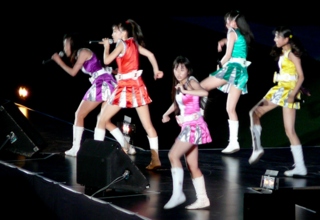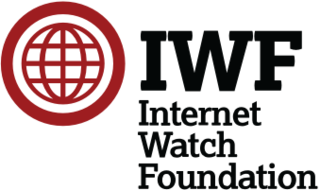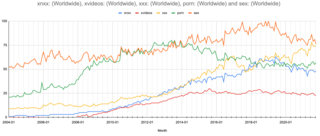
In Japan, pornography has unique characteristics that readily distinguish it from western pornography. Pornographic films are known as "adult videos" (AV) in Japan, so Japanese adult videos (JAV) refers to the Japanese pornographic film industry. Animated films are referred to as hentai in English, but in Japan the terms "adult anime" and "erotic animation" are used. In addition to pornographic videos and magazines featuring live actors, there are now categories of pornographic manga and anime, and pornographic computer games.

Pornography laws by region vary throughout the world. The production and distribution of pornographic films are both activities that are legal in some but not all countries, as long as the pornography features performers aged above a certain age, usually 18 years. Further restrictions are often placed on such material.

Pornography has been dominated by a few pan-European producers and distributors, the most notable of which is the Private Media Group that successfully claimed the position previously held by Color Climax Corporation in the early 1990s. Most European countries also have local pornography producers, from Portugal to Serbia, who face varying levels of competition with international producers. The legal status of pornography varies widely in Europe; its production and distribution are illegal in countries such as Ukraine, Belarus and Bulgaria, while Hungary has liberal pornography laws.

A junior idol, also known as a chidol or low teen idol, is a type of entertainers under the age of 18 or 16 who are manufactured and marketed for their image, attractiveness and personality. It is a sub-category of the idol culture in Japanese pop entertainment. Junior idols are primarily gravure idols who are marketed through photo books and image DVDs, but some are also trained in singing and acting. Unlike other child models, idols are commercialized through merchandise and endorsements by talent agencies, while maintaining an emotional connection with a passionate consumer fan base.

The Internet Watch Foundation (IWF) is a global registered charity based in Cambridge, England. It states that its remit is "to minimise the availability of online sexual abuse content, specifically child sexual abuse images and videos hosted anywhere in the world and non-photographic child sexual abuse images hosted in the UK." Content inciting racial hatred was removed from the IWF's remit after a police website was set up for the purpose in April 2011. The IWF used to also take reports of criminally obscene adult content hosted in the UK. This was removed from the IWF's remit in 2017. As part of its function, the IWF says that it will "supply partners with an accurate and current URL list to enable blocking of child sexual abuse content". It has "an excellent and responsive national Hotline reporting service" for receiving reports from the public. In addition to receiving referrals from the public, its agents also proactively search the open web and deep web to identify child sexual abuse images and videos. It can then ask service providers to take down the websites containing the images or to block them if they fall outside UK jurisdiction.
Legal frameworks around fictional pornography depicting minors vary depending on country and nature of the material involved. Laws against production, distribution and consumption of child pornography generally separate images into three categories: real, pseudo, and virtual. Pseudo-photographic child pornography is produced by digitally manipulating non-sexual images of real minors to make pornographic material. Virtual child pornography depicts purely fictional characters. "Fictional pornography depicting minors", as covered in this article, includes these latter two categories, whose legalities vary by jurisdiction, and often differ with each other and with the legality of real child pornography.

Internet pornography is any pornography that is accessible over the Internet; primarily via websites, FTP connections, peer-to-peer file sharing, or Usenet newsgroups. The greater accessibility of the World Wide Web from the late 1990s led to an incremental growth of Internet pornography, the use of which among adolescents and adults has since become increasingly popular.

In the United States, child pornography is illegal under federal law and in all states and is punishable by up to life imprisonment and fines of up to $250,000. U.S. laws regarding child pornography are virtually always enforced and amongst the harshest in the world. The Supreme Court of the United States has found child pornography to be outside the protections of the First Amendment to the United States Constitution. Federal sentencing guidelines on child pornography differentiate between production, distribution, and purchasing/receiving, and also include variations in severity based on the age of the child involved in the materials, with significant increases in penalties when the offense involves a prepubescent child or a child under the age of 18. U.S. law distinguishes between pornographic images of an actual minor, realistic images that are not of an actual minor, and non-realistic images such as drawings. The latter two categories are legally protected unless found to be obscene, whereas the first does not require a finding of obscenity.
Section 163.1 of the Criminal Code of Canada forbids the production, distribution, and possession of child pornography, which are punishable by a maximum of ten or fourteen years of imprisonment depending on the offense. Portions of the law concerning one-year mandatory minimums for possession and making of child pornography have since been struck down as unconstitutional.
The production, sale, distribution, and commercialization of child pornography in Japan is illegal under the Act on Punishment of Activities Relating to Child Prostitution and Child Pornography, and the Protection of Children (1999), and is punishable by a maximum penalty of five years in prison and/or a fine of ¥5,000,000. Simple possession of child pornography was made illegal by an amendment to the act in 2014. Virtual child pornography, which depicts wholly-fictional characters, is legal to produce and possess.
The Australian law prohibits all sexual depictions of children under an age set by state and territory legislation. The relevant ages are under 16 in the Australian Capital Territory, New South Wales, Queensland and Western Australia, under 17 in South Australia, and under 18 in the other jurisdictions and under federal law. The laws covering child pornography are differently defined in the various Australian jurisdictions, as are the penalties. The laws also cover depictions of sexual acts involving people over the threshold age who are simulating or otherwise alluding to being underage, even if all those involved are of a legal age. People have been successfully prosecuted after describing acts of abuse via MMS.
Child pornography is erotic material that depicts persons under the age of 18. The precise characteristics of what constitutes child pornography varies by criminal jurisdiction.
In the Netherlands, child pornography is illegal, making it one of the 103 out of 193 UN member states where it is illegal.
In the Philippines, pornography is not specifically defined in Philippine law, but the Revised Penal Code of the Philippines considers certain acts to be obscene or indecent and these are prohibited as immoral doctrines, obscene publications, indecent shows, or other similar material or portrayals that advocate human immorality, obscenity, and indecency. Philippine legislation penalizes participation in these unlawful activities, and Republic Act No. 7610 extends punishment to those involved in child abuse, child exploitation, child prostitution and discrimination of children.
Internet censorship in South Africa is a developing topic.

Pornography in Pakistan is subject to several legal provisions. The Government of Pakistan has placed ban on internet websites containing such material since November 2011. Major pornography website are already barred in Pakistan. In 2016, it was reported that government of Pakistan ordered Internet Service Providers (ISPs) in Pakistan to block more than 400,000 websites which contained pornographic content. Later in 2019, around 800,000 additional website containing pornographic content were banned by the Pakistan Telecom Authority on the order of government of Pakistan.
Revenge porn is the distribution of sexually explicit images or videos of individuals without their consent. The material may have been made by a partner in an intimate relationship with the knowledge and consent of the subject at the time, or it may have been made without their knowledge. The subject may have experienced sexual violence during the recording of the material, in some cases facilitated by narcotics such as date rape drugs which also cause a reduced sense of pain and involvement in the sexual act, dissociative effects and amnesia. The possession of the material may be used by the perpetrators to blackmail the subjects into performing other sexual acts, to coerce them into continuing a relationship or to punish them for ending one, to silence them, to damage their reputation, and/or for financial gain. In the wake of civil lawsuits and the increasing numbers of reported incidents, legislation has been passed in a number of countries and jurisdictions to outlaw the practice, though approaches have varied and been changed over the years. The practice has also been described as a form of psychological abuse and domestic violence, as well as a form of sexual abuse.
Project Spade, an international police investigation into child pornography, began in October 2010 in Toronto, Canada. The investigation started when Toronto Police Service officers made on-line contact with a man who was alleged to have been sharing pornographic videos via the Internet and by mail. The investigation eventually covered over 50 countries. 348 people were arrested internationally, and 386 children were said to have been rescued. The primary producers were Igor Rusanov and Andrey Ivanov in Crimea, Ukraine, Markus Roth in Romania, and Paul Kruger in Germany.

Pornography in Asia is pornography created in Asia, watched in Asia, or consumed or displayed in other parts of the world as one or more genres of Asian porn.

In China, including the People's Republic of China (PRC) and the Republic of China (ROC/Taiwan), the pornography laws and definitions vary depending on the governing authority. In the PRC there are criminal laws which prohibit the production, dissemination, and selling of sexually explicit material, and anyone doing so may be sentenced to life imprisonment. There is an ongoing campaign against "spiritual pollution", the term referencing the Chinese Communist party's Anti-Spiritual Pollution Campaign of 1983. Although pornography is illegal, it is available via the Internet. Nationwide surveys between the years 2000 and 2015 revealed "more than 70 percent of men aged 18 to 29 said they had watched porn in the past year".








